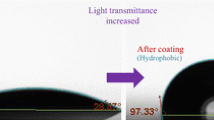Abstract
As a consequence of regulatory pressure to reduce solvent emissions, there is high growth rate of “compliant technologies” such as waterborne (WB) coatings. However, a change from conventional solventborne (SB) to WB technologies should not compromise the protective function of the coatings and the used raw materials. The use of light stabilizers, such as UV absorbers (UVA) and hindered amine light stabilizers (HALS) are state-of-the-art and largely improve the coating durability and service lifetime. Today in the case of UVA one has to differentiate between inorganic and organic products: the most widely used organic UVA for coating applications are 2-(2-hydroxyphenyl)-benzotriazole (BTZ) and 2-hydroxyphenyl-s-triazine (HPT) derivatives. Inorganic products are ideally nano particulate materials—so-called mineral screeners (MS)—comprised of titanium dioxide (TiO2), zinc oxide (ZnO), or cerium oxide (CeO2). The challenge here is to convert existing products which are in general hydrophobic substances into product forms that enable easy incorporation and unproblematic dispersion into WB systems. This article describes UV absorbers which are commercially available for waterborne coatings. Different classes are tested with regard to their protective function in joinery coatings as well as with regard to their influence on coatings color and transparency. The findings of this study showed clearly that the 2-hydroxyphenyl-s-triazine class outperforms all other UVA in terms of long-term performance without influencing initial coating properties.







Similar content being viewed by others
References
Valet, A, Light Stabilizers for Paints, pp. 45–128, C.R. Vincentz Verlag, Hannover, 1997, ISBN 3-87870-443-7
Decker, C, Biry, S, Zahouily, K, “Photostabilisation of Organic Coatings.” Polym. Degrad. Stab., 49 111–119 (1995)
Schaller, C, Rogez, D, Braig, A, “Hydroxyphenyl-s-triazines: Advanced Multi-purpose UV-Absorbers for Coatings.” J. Coat. Technol. Res., 5 (1) 25–31 (2008)
Kurumada, T, Ohsawa, H, Yamazaki, T, “Synergism of Hindered Amine Light Stabilizers and UV-Absorbers.” Polym. Degrad. Stab., 19 (3) 263–272 (1987)
Schaller, C, Rogez, D, Braig, A, “Hindered Amine Light Stabilizers in Pigmented Coatings.” J. Coat. Technol. Res., 6 (1) 81–88 (2008)
Stährfeld, A, Braig, A, “Advanced UV Protection of Automotive Clear Coatings.” Proceedings of XXVI FATIPEC Congress, Dresden, Germany, 2002
Peter, W, Schaller, C, Schellenberg, C, Rogez, D, “A New Concept of Aqueous Additive Preparations for Water-Borne Coatings.” Proceedings from the Water-borne and High-solids Coatings Conference, Brussels, Belgium, 2006
Landuydt, T, Rogez, D, “Hiding the Hydrophobicity—Encapsulated Organic Light Stabilizer.” Eur. Coat. J., 4 (8) 34–38 (2008)
Hayoz, P, Peter, W, Rogez, D, “Colour and Light Stabilisation of Untreated and Stained Wood for Indoor Use.” Farbe und Lack, 109 (7) 26–33 (2003)
Schaller, C, Rogez, D, “New Approaches in Wood Coating Stabilization.” J. Coat. Technol. Res., 4 (4) 401–409 (2007)
Author information
Authors and Affiliations
Corresponding author
Rights and permissions
About this article
Cite this article
Schaller, C., Rogez, D. & Braig, A. Organic vs inorganic light stabilizers for waterborne clear coats: a fair comparison. J Coat Technol Res 9, 433–441 (2012). https://doi.org/10.1007/s11998-011-9380-8
Published:
Issue Date:
DOI: https://doi.org/10.1007/s11998-011-9380-8




